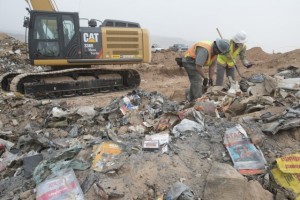At first glance, punk archaeology seems like an oxymoron, how could punk, inherently about disobeying the man, possibly have anything to do with the disciplined study of artifacts? However punk archaeology gets its name because it aims to approach archaeology in an unorthodox manner, similar to how punk musicians approached their music. Punk archaeology looks at, not just the ancient but also, the overlooked recent objects as artifacts, and through this study critiques modern society publicly, in order to reach and effect a wider audience. But just because punk archaeology’s intends to challenge established modes of thought doesn’t mean it succeeds.
The Atari excavation of the landfill in Alamogordo, NM, is an archetype of punk archaeology but does this excavation challenge the typical conventions of archaeology and/or the public’s established beliefs about archaeology? As Andrew Reinhard mentions in “Why We Dug Atari”, archaeologists doing the Atari excavation plan on publishing their findings in academic journals (the common end goal of most traditional archaeology) and set out not to dispel the widespread Atari myth but rather to examine the stratigraphy of the site and the lifecycle of consumer products (Caraher, Guins, Reinhard, Rothaus, & Weber, 2014). This excavation examined the recent past to of criticize our current culture, in this case our culture of consumerism and convenience where we quickly discard whatever isn’t the latest model. But rather than go against traditional archaeology this topic is a common archaeological pursuit already being examined by garbologists. Therefore, although this excavation was done with a bulldozer, an unconventional tool, to find a video game, an unconventional artifact, the core of the excavation was rather conventional.
Furthermore as there is no real explanation of how these punk archaeologists excavated this site, specifically whether the trash was recorded through standard scientific measures, it’s unclear how unconventional this study was. If conventional scientific measures were used it will increase adherence to normal modes of archaeological thinking while if scientific measures were not used can this study even be classified as archaeology? And if it falls into some other disparate field then it can’t be challenging archaeological norms anymore then a Chinese speaker can, by speaking Chinese, challenge a Spanish speaker’s standard mode of speaking Spanish.

Figure2: On-site audience consisted of gamers who were more interested in the video game than the archaeology
Additionally this excavation was highly publicized, with an on-site audience of gamers and media coverage to reach the general public. But just because the public was present doesn’t mean their archaeological views were challenged or even that they got the punk archaeologist’s purpose. The punk archaeologists were trying to challenge the conception that archaeology is restricted to the study of extravagant long gone cultures and how instead even what has more recently been discarded and forgotten can provide valuable information and cultural insight. However, the gamers present only wanted to know if Atari had dumped/hidden its rejects and showed up for this myth busting. Even the team of archaeologists admitted that their true purpose was overlooked in media and by the public (Caraher, Guins, Reinhard, Rothaus, & Weber, 2014). In conclusion, instead of challenging modes of archaeological thought punk archaeology adheres to them and, due to the disconnect between the purpose of the excavation and the entertainment experienced by the public, is also unsuccessful in correcting/expanding the public’s opinion on archaeology despite the potential media attention grants it to do so.
Resources: http://www.theatlantic.com/technology/archive/2014/08/why-we-dug-atari/375702/?single_page=true
Image 2: http://mashable.com/2014/04/26/legend-confirmed-atari-2600-e-t-game-discovered-at-new-mexico-dig/
http://und.edu/features/2014/06/atari.cfm

